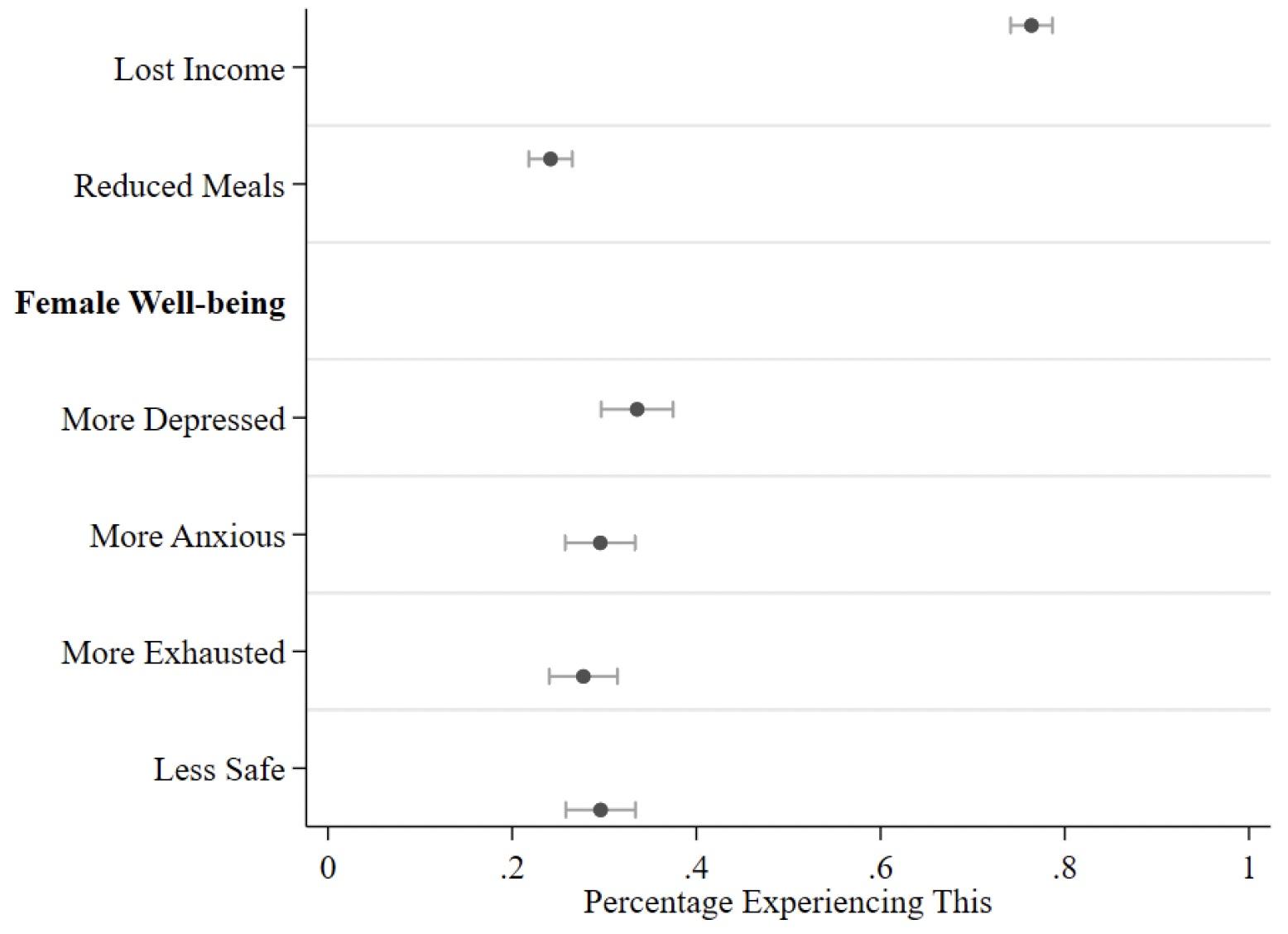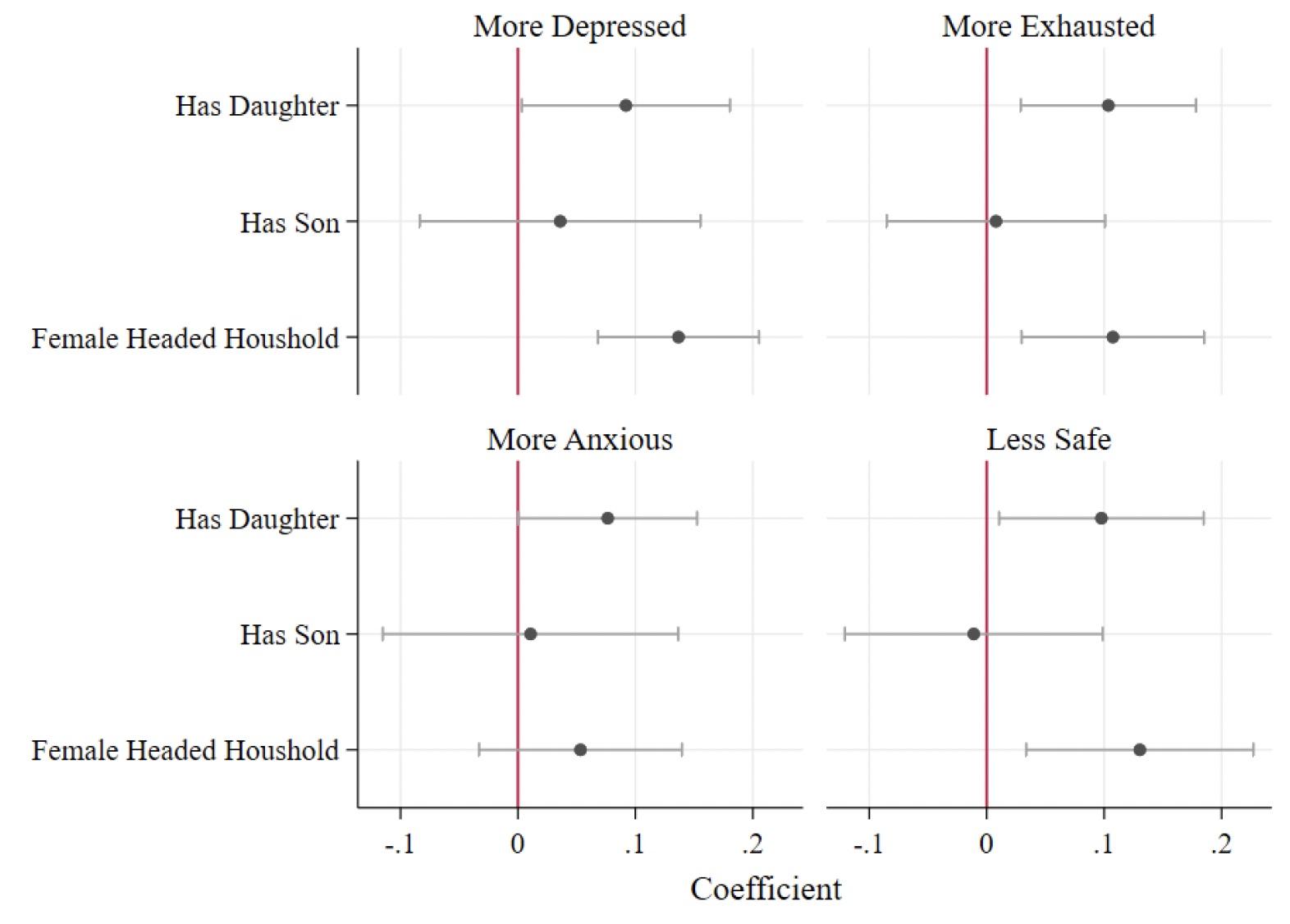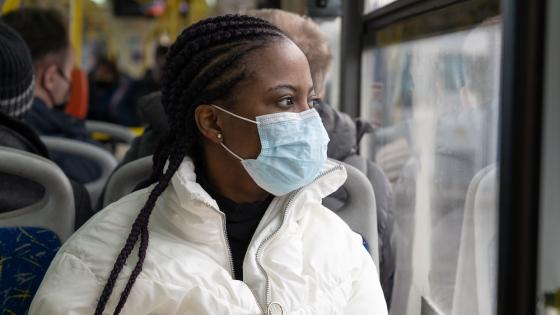The COVID-19 pandemic brought the dual crises of disease and the containment policies designed to mitigate it. While lockdowns may be crucial to stem the spread of COVID-19 cases, when not combined with adequate social safety nets, they can also generate economic and mental distress (Cuesta and Hannan 2021, Ma et al. 2021, Bogmans 2021). Even though contemporaneous work examines the consequences of the pandemic on mental health and wellbeing, much of this work is concentrated in high-income countries (Brodeur et al. 2021, Armbruster and Klotzbücher 2020, Adams-Prassl et al. 2020 and 2021, Etheridge and Spantig 2020, Hvide and Johnsen 2021), or the middle-income settings of Turkey (Altindag et al. Forthcoming, Özdin and Bayrak Özdin 2020), Brazil (Ferreira et al. 2021), and Egypt (El-Zoghby et al. 2020).
In a new paper (Bau et al. 2021), we focus on a lower-middle-income country, where substitutes for in-person transactions are scarce and formal safety nets are limited (Mobarak and Barnett-Howell 2020, Egger et al. 2021, Bogmans 2021, Ma et al. 2021). Women may be especially vulnerable in these settings given gender norms, low availability of mental health services (Angelucci and Bennett 2021, Vlassopoulos et al. 2021), and weaker state capacity.
Early evidence suggests that rural India suffered from significant disruptions to food supply chains and reductions in economic livelihoods, perhaps affecting the physical and mental wellbeing of vulnerable populations (Afridi et al. 2020, Purohit 2020, Kumar and Singh 2021). Yet without the systematic measurement of these outcomes for at-risk populations, the extent of this crisis, and its relationship with containment policies is difficult to quantify.
To examine how women fare, we conduct a large phone survey across six states in rural North India. India's highly spatially variant containment policies allow us to study how the pandemic and its containment policies affected nutrition, incomes, and female mental health.
Phone survey
Building off a sample of households that were interviewed in-person in autumn 2019, we conduct a timely phone re-survey in August 2020 with IDInsight, near the height of the first COVID-19 wave in India, when India had between 50,000 and 70,000 new COVID-19 cases per day. This setup not only gives us measures of pre-pandemic baseline characteristics but also allowed trusted surveyors, who had already developed relationships with these households, to inquire about women's mental wellbeing. We conducted the phone survey in 20 districts across six states (Rajasthan, Uttar Pradesh, Bihar, Jharkhand, Madhya Pradesh, and Maharashtra). Households participated in a 20-30 minute survey, during which we surveyed both a household-head and a female respondent.
The impact of the aggregate COVID shock
We find that the pandemic is associated with drastic income losses and increased food insecurity, as well as declines in female mental health and wellbeing. The top panel of Figure 1 reports the distribution of the head's self-reported income before and after the pandemic and shows a dramatic drop in income. On average, the household-head's monthly income fell from 8,625 rupees in a normal month to 3,584 rupees during COVID, a decline of about 50%. The bottom panel shows that 76% of respondents report reduced income for themselves, and 24% report reduced meals for someone in the household.
Next, we examine whether female respondents report that their feelings of depression, exhaustion, anxiety, and safety have worsened over the course of the pandemic. For each measure, roughly 30% of respondents indicate that their wellbeing had worsened.
Figure 1 Impact of aggregate COVID-19 shock on income and female wellbeing
Notes: The top panel reports the distribution of household head's self-reported income in the current month and a normal month in rupees. The bottom panel reports the percent of households reporting reduced income, reduced meals, and worse female wellbeing for different measures.
The impact of containment policies
Identifying the impact of containment policies is challenging in most settings, as containment is not randomly assigned and is often mandated at the state or national level. We leverage the fact that containment exposure is uniquely heterogeneous in our setting. While India initially pursued a nationwide lockdown in response to the pandemic, from June 2020 onward, it had a patchwork of containment zones in which lockdown measures were imposed. These zones were determined by district or town authorities, and their size could be as small as one apartment building or a 1 km radius (Express News Service 2020). This mosaic of policies within relatively small geographic areas provides us with a unique opportunity to use meaningful variation in lockdown policies to assess the relationship of containment with mental health and other measures of wellbeing.
Female wellbeing, socioeconomic, and nutritional outcomes
The top panel of Figure 2 shows that higher containment is associated with a worsening of all four female wellbeing outcomes. We find that moving from no containment to average levels of containment is associated with a 13 percentage point increase in the likelihood that feelings of depression have worsened and a 20 percentage point increase in the likelihood that feelings of tiredness have increased. Containment is also associated with a significant increase in depression, feeling more anxious, and feeling less safe.
As shown in the bottom panel of Figure 2, we also investigate the relationship between containment and socioeconomic and nutritional outcomes. Households in higher containment areas lost income and experienced increased food insecurity. Moving from no containment to average levels of containment is associated with 0.6 additional household members having lost income and an 8 percentage point increase in the likelihood of reduced daily meals. By comparing current consumption to pre-pandemic levels of consumption from the National Family Health Survey (NFHS 4), we find that moving from no containment to average levels of containment is associated with a 13 percentage point increase in the share of food categories for which a woman's consumption is below her district's pre-pandemic median. For males, the coefficient is smaller and not statistically significant.
Two pieces of evidence suggest that the associations we report may be capturing the direct effects of containment, even though containment policies were not randomly assigned to geographic units. First, living in an area with a higher prevalence of lockdowns is not systematically associated with pre-treatment socioeconomic measures, either for outcomes collected from our own sample prior to the pandemic or for district-level measures of food intake in the 2015-16 NFHS. Second, the inclusion of district-level cumulative measures of case and death rates in the regression allows us to compare two areas with the same COVID-19 incidence but different containment policies and does not change the estimates.
Figure 2 Containment and female wellbeing, socioeconomic, and nutritional outcomes
Notes: These figures report the coefficients of regressing female wellbeing outcomes (top) and socioeconomic and nutritional outcomes (bottom) on district-level containment. ‘Below Median Consumption’ refers to indicators for the share of food categories for which the respondent's intake is below the gender-specific district-level median in the pre-pandemic NFHS 4.
Family structure and vulnerable women
Last, we examine how the relationship between the aggregate COVID-19 shock and the outcomes of interest vary with the pre-existing vulnerability of women. Recent evidence from high-income settings suggests that working mothers with young children are particularly affected by lockdowns (Zamarro and Prados 2021). While relative female labour force participation in India is lower, traditional gender norms may make women particularly vulnerable at times of socio-economic stress. We find that the negative relationship between the pandemic and mental health is significantly exacerbated for women who have daughters. A woman is 9 percentage points more likely to have worsening feelings of depression and 10 percentage points more likely to have worsening feelings of tiredness if she has a daughter (see Figure 3). Having a daughter is also associated with an increase in anxiety and reduction in feelings of safety. This is consistent with the existence of strong son preference in India, where daughters may lower a woman's status within the household (Jayachandran 2015).
The adverse effects on wellbeing are also worsened when the head of the household is female, although we caution that female-headed household's socioeconomic status could also be systematically different from male-headed households. When the respondent lives in a female headed household, she is more likely to have worsening feelings of depression and exhaustion, and an increased likelihood of feeling less safe.
Figure 3 Household structure and female wellbeing
Notes: These figures report the coefficients of regressing female wellbeing outcomes on indicators for having a daughter, having a son, and living in a female headed household.
Policy implications
While potentially crucial for public health purposes, in India, containment is associated with large negative consequences for both standard socioeconomic outcomes and outcomes that are harder to observe and measure, like mental health. The effects of containment policies may be similar in other low-income contexts with limited social insurance. In such contexts, more vulnerable populations may be particularly harmed by both the direct effects of the pandemic and these policies. These results suggest that policymakers should target aid, particularly access to food, to vulnerable households and women.
Editors’ note: A more India-focused summary of this article was first published on Ideas For India.
References
Adams-Prassl, A, T Boneva, M Golin, and C Rauh (2020), “The impact of the Coronavirus lockdown on mental health: Evidence from the US”, Working Papers 2020-030, Capital and Economic Opportunity Working Group.
Adams-Prassl, A, T Boneva, M Golin, and C Rauh (2021), “Lockdowns widen the gender gap in mental health”, VoxEU.org, 27 April.
Afridi, F, A Dhillon, and S Roy (2020), “How has Covid-19 crisis affected the urban poor? Findings from a phone survey”, Ideas For India, 23 April.
Altindag, O, B Erten, and P Keskin (2020), “Mental health costs of lockdowns: Evidence from age-specific curfews in Turkey”, IZA Discussion Papers No. 14281.
Angelucci, M and D Bennett (2021), “The economic impact of depression treatment in India”, IZA Discussion Papers No. 14393.
Armbruster, S and V Klotzbücher (2020), “Lost in lockdown? COVID-19, social distancing, and mental health in Germany”, Working Paper, Diskussionsbeiträge.
Bau, N, G Khanna, C Low, M Shah, S Sharmin, A Voena (2021), “Women's wellbeing during a pandemic and its containment”, CEPR Discussion Paper 16424.
Bogmans, C, A Pescatori, E Prifti (2021), “Food (in)security: A potentially underrated collateral damage of the pandemic”, VoxEU.org, 5 June.
Cuesta, J P and S A Hannan (2021), “Recovering from pandemics: Policies and structural features matter”, VoxEU.org, 12 August.
Brodeur, A, A E Clark, S Fleche, and N Powdthavee (2021), “COVID-19, lockdowns and well-being: Evidnce from Google trends”, Journal of Public Economics 193: 104346.
Egger, D, E Miguel, S S Warren, A Shenoy, E Collins, D Karlan, D Parkerson, A M Mobarak, G Fink, C Udry, M Walker, J Haushofer, M Larrebourne, S Athey, P Lopez-Pena,S Benhachmi, M Humphreys, L Lowe, N F Meriggi, A Wabwire, C A Davis, U J Pape, T Graff, M Voors, C Nekesa, and C Vernot (2021), “Falling living standards during the COVID-19 crisis: Quantitative evidence from nine developing countries”, Science Advances 7(6).
El-Zoghby, S M, E M Soltan, and H M Salama (2020), “Impact of the COVID-19 pandemic on mental health and social support among adult Egyptians”, Journal of Community Health 45(4): 689–95.
Etheridge, B and L Spantig (2020), “The gender gap in mental well-being during the Covid-19 outbreak: Evidence from the UK,” ISER Working Paper Series 2020-08.
Express News Service (2020), “Explained: What are containment zones, how are they demarcated?” The Indian Express, 3 July.
Ferreira, F, J B Lopes-Silva, G M Siquara, E C Manfroi, and P M de Freitas (2021), “Coping in the Covid-19 pandemia: How different resources and strategies can be risk or protective factors to mental health in the Brazilian population”, Health Psychology and Behavioral Medicine 9(1): 182–205.
Hvide, H and J Vedeler Johnsen (2021), “COVID-19 and mental health: A longitudinal population study through 2020”, VoxEU.org, 7 July.
Jayachandran, S (2015), “The roots of gender inequality in developing countries”, Economics 7(1): 63–88.
Kumar, H and K D Singh (2021), “Covid-19 pushes India’s middle class toward poverty”, The New York Times, 23 April.
Ma, L, G Shapira, D de Walque, Q-T Do, J Friedman, A Levchenko (2021), “The intergenerational mortality trade-off of COVID-19 lockdown policies in low- and middle-income countries”, VoxEU.org, 19 July.
Mobarak, A M and Z Barnett-Howell (2020), “Poor countries need to think twice about social distancing”, Foreign Policy 10.
Özdin, S and Ş B Özdin (2020), “Levels and predictors of anxiety, depression and health anxiety during COVID-19 pandemic in Turkish society: The importance of gender”, The International Journal of Social Psychiatry 66(5): 504–11.
Purohit, K (2020), “India COVID-19 lockdown means no food or work for rural poor”, Al Jazeera, 3 April.
Vlassopoulos, M, A Siddique, T Rahman, D Pakrashi, A Islam, and F Ahmed (2021), “Improving women’s mental health during a pandemic”, Working Paper.
Zamarro, G and M J Prados (2021), “Gender differences in couples’ division of childcare, work and mental health during COVID-19”, Review of Economics of the Household 19(1): 11–40.














